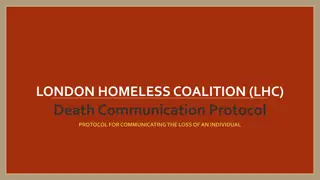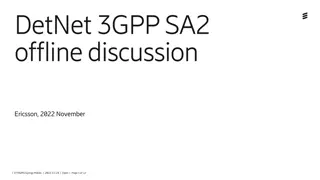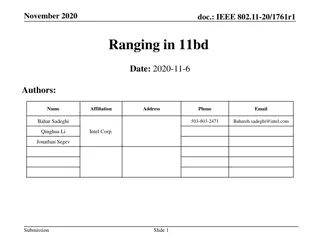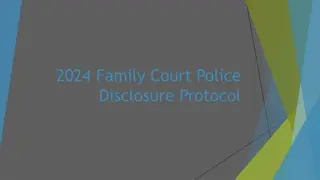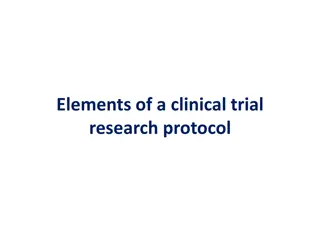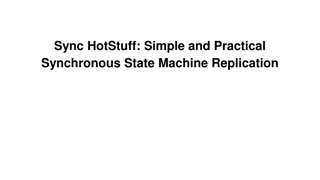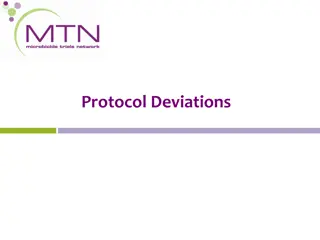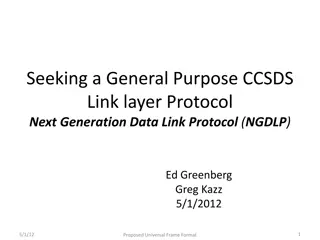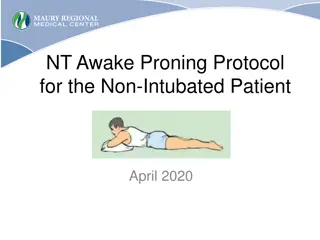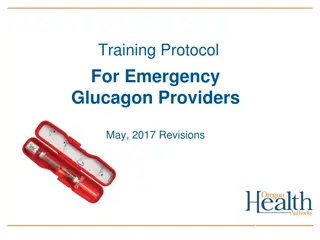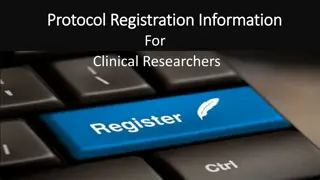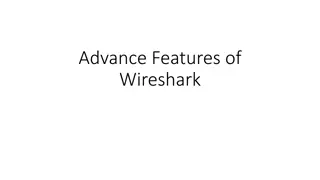
Comparative Study on Pneumatic Vitreolysis for Vitreomacular Traction
Explore the randomized clinical trial comparing pneumatic vitreolysis with observation for treating vitreomacular traction. Understand the implications of different treatment options, including ocriplasmin and vitrectomy, on visual outcomes. Delve into the potential public health impact and cost savings associated with adopting pneumatic vitreolysis as a management strategy for VMT.
Download Presentation

Please find below an Image/Link to download the presentation.
The content on the website is provided AS IS for your information and personal use only. It may not be sold, licensed, or shared on other websites without obtaining consent from the author. If you encounter any issues during the download, it is possible that the publisher has removed the file from their server.
You are allowed to download the files provided on this website for personal or commercial use, subject to the condition that they are used lawfully. All files are the property of their respective owners.
The content on the website is provided AS IS for your information and personal use only. It may not be sold, licensed, or shared on other websites without obtaining consent from the author.
E N D
Presentation Transcript
Gas for Vitreomacular Traction RCT (Protocol AG) Gas for Macular Hole Single-Arm Study (Protocol AH) Protocol AG Chair: Clement Chan, MD Protocol AH Chair: Calvin Mein, MD DRCR.net
Protocol AG Randomized Clinical Trial Assessing the Effects of Pneumatic Vitreolysis on Vitreomacular Traction 2
Background Treatment options for VMT include observation, intraocular injection of ocriplasmin, and vitrectomy. Observation: VMT may spontaneously resolve Multiple reports (30-40% given sufficient waiting period, but unpredictable, prolonged) Ocriplasmin: reports of ocular complications 26 to 48% success; high cost; anecdotal reports of complications (vision loss, ERG changes, photoreceptor/zonule dehiscence, dyschromatopsia) Vitrectomy: costly and includes usual risks of surgery >90% success, invasive, high cost 3
Background 1.5% of the population is estimated to have eye diseases caused by or associated with vitreomacular adhesion1 Pneumatic vitreolysis (PVL) may serve as an alternative Lower cost In-office setting (no scheduling or coordinating issues associated with surgery) Case series (1995 to 2017) have reported: 56-85% success rate of VMT release Low rate of adverse events 1. Karth, PA, Shah SA. Vitreomacular traction syndrome. http://eyewiki.aao.org/Vitreomacular_Traction_Syndrome. Oct 17, 2015 4
Public Health Impact Retrospective data alone (with all the confounding variables) are unable to provide sufficient information to guide management options If level-one evidence is achieved in favor of PVL, it can lead to a change in practice pattern on management of VMT not only in the US, but also on the global stage Such a paradigm shift in management of VMT could have major implications on medical economics and cost savings 5
Study Objective Primary To compare the proportion of eyes with foveal VMT (symptomatic VMA) release on OCT after PVL with gas injection vs. observation (sham injection) in eyes with VMT without an associated macular hole Secondary To evaluate visual function outcomes at 24 weeks after gas injection is performed compared with observation. 6
Study Design Multi-Center Randomized Clinical Trial (124 Eyes) At least 1 eye that meets all of the following criteria: Vitreomacular adhesion on OCT 3,000 m Reading center confirmation required for eligibility Best corrected ETDRS visual acuity equivalent of 20/32 to 20/400 Decreased visual function attributed to VMT No macular or lamellar hole Prompt Vitrectomy not required Observation (Sham injection) PVL (Injection of C3F8 gas) Primary Outcome: Proportion of eyes with VMT release on OCT without rescue vitrectomy at 24 weeks 7
Major Patient Eligibility Criteria Able and willing to avoid high altitude travel, including airline travel, until gas resolution (~6-8 weeks) Able and willing to avoid supine position until gas resolution for phakic patients Able and willing to wear a wristband that informs any medical personnel that the patient has a gas bubble in the eye 8
Major Ocular Eligibility Criteria Investigator and participant willing to wait 6 months before surgical intervention if visual acuity remains stable (unless complications; e.g. macular hole development, retinal tears or detachment) Exclusions: History of prior gas injection, ocriplasmin injection, or intraocular injection for any reason Prior vitrectomy High level of myopia History of uncontrolled glaucoma IOP 30 mmHg 9
Study Design Informed Consent, Baseline Testing Dropped Ineligible Reading Center Review Dropped Ineligible Randomization Observation (Sham Injection) Injection of C3F8 Gas (0.3 mL) 1 week 1 week 4 weeks 4 weeks 12 weeks 12 weeks Primary outcome visit 24 weeks 24 weeks 10
Baseline Testing Procedures 1. The following will be performed on both eyes E-ETDRS visual acuity Visual function testing (myVisionTrack) OCT Eye exam 2. Reading Center will review OCT scans to confirm eligibility Same day RC review will be available if required but should be limited to cases when scheduling a separate randomization day is difficult 3. Eligible eyes may then be randomized (must be within 8 days of baseline testing) 11
Process of Reading Center Confirmation The Reading Center must confirm study eye eligibility on OCT For same day grading, OCT scans must be uploaded by 2 pm Eastern Otherwise, the participant will need to return on a separate day for randomization (RCT only) and the injection 13
Follow-Up Testing Procedures E-ETDRS visual acuity Visual function testing (myVisionTrack) 12 and 24 weeks only OCT study eye only Eye exam study eye only 14
Criteria for Rescue Vitrectomy For study eyes in both treatment groups, vitrectomy may be performed if one of the following occurs: 1. Visual acuity decreases at least 10 letters at a single visit (not including the 1-week visit) or at least 5 letters at two consecutive visits (not including the 1-week visit) compared with baseline that is thought to be related to VMT 2. Complication requires prompt surgical intervention (e.g., macular hole, retinal detachment, non-clearing vitreous hemorrhage). Otherwise, protocol chair approval must be obtained for alternative treatment. 15
Example of a good candidate for AG (RCT) Eagle sign PVL 16
Protocol AH Single-Arm Study Assessing the Effects of Pneumatic Vitreolysis on Macular Hole 17
Background PVL for Macular Hole (MH) offers a lower cost, low risk alternative to Vitrectomy Understanding the rates of MH closure and VMT release in eyes with full-thickness macular holes treated with PVL is of interest given the low cost and convenience of gas injection in the office setting as well as a lowrate of adverse events reported in prior retrospective studies 18
Prior case series of PVL for Macular Hole Chan (1995) Closure of stage-2 MH: 50% (N = 6) Jorge et al Closure of stage-2 MH: 83% (N = 6) Steinle et al Closure of full-thickness MH: 67% (N = 3) Chan and Mein (Retina, 2017) Closure stage-2 MH: 67% with single injection (N = 15) 19
Rationale for Single-Arm Study Eyes with MH need treatment, therefore randomization to a sham arm would be inappropriate Vitrectomy results in nearly 100% hole closure making it an unnecessary (and expensive) control group choice Even if this proposed study finds that PVL is only moderately successful, physicians and patients may decide to attempt PVL in the office first, before proceeding with more costly, invasive surgery Thus, even without a control group, the results from this study will provide data of value for physicians and patients to make informed decisions about treatment course 20
Public Health Impact If a large percentage of eyes can achieve MH closure with a simple in-office, low-cost procedure, while averting the invasiveness and expense of a vitrectomy for this condition, this would provide a viable first-line treatment option 21
Study Objective To obtain estimates for the proportion of eyes with macular hole closure of the inner retinal layers for eyes with VMT and full-thickness macular holes treated with PVL 22
Study Design Multi-Center Single-Arm Study (50 Eyes) At least 1 eye that meets all of the following criteria: Full-thickness macular hole 250 microns at the narrowest point, confirmed by central reading center Vitreomacular adhesion on OCT 3,000 microns, confirmed by central reading center Best corrected ETDRS visual acuity equivalent of 20/25 to 20/400 PVL (Injection of C3F8 gas) Primary Outcome: Proportion of eyes with macular hole closure of the inner retinal layers at 8 weeks without rescue treatment 23
Major Patient Eligibility Criteria Able and willing to avoid high altitude travel, including airline travel, until gas resolution (~6-8 weeks) Able and willing to avoid supine position until gas resolution for phakic patients Able and willing to wear a wristband that informs any medical personnel that the patient has a gas bubble in the eye Able and willing to position face down for at least 50% of the time for at least 4 days post-injection to facilitate macular hole closure 24
Major Ocular Eligibility Criteria Exclusions: History of prior gas injection, ocriplasmin injection, or intraocular injection for any reason Prior vitrectomy High level of myopia History of uncontrolled glaucoma IOP 30 mmHg 25
Study Design Informed Consent, Baseline Testing Dropped Ineligible Reading Center Review Dropped Ineligible Injection of C3F8 Gas (0.3 mL) 1 week 4 weeks Primary outcome visit 8 weeks 24 weeks 26
Baseline Testing Procedures 1. The following will be performed on both eyes E-ETDRS visual acuity OCT Eye exam 2. Reading Center will review OCT scans to confirm eligibility Same process as Protocol AG regarding Reading Center confirmation of study eye eligibility 3. Eligible eyes may then receive gas injection (must be within 8 days of baseline testing) 27
Follow-Up Testing Procedures E-ETDRS visual acuity OCT study eye only Eye exam study eye only 28
Criteria for Rescue Vitrectomy Vitrectomy should not be performed due to failure of macular hole closure prior to 4 weeks without protocol chair approval Between 4 and 8 weeks, vitrectomy may only be performed (but is not required) if the macular hole size is not improving from baseline After 8 weeks, vitrectomy can be performed at investigator discretion. 29
Example of a good candidate for AG (RCT) Eagle sign PVL 30
Example of good candidate for AH (single-arm) Case 1 PVL Case 2 PVL 31
C3F8 Perfluoropropane Commercially available C3F8 (Alcon or Sonomed Escalon) delivered from a pressurized canister and passed through a Millipore filter for injection into the vitreous cavity FDA approved as a surgical aid for use in the treatment of retinal detachment by pneumatic retinopexy Diffuses from the eye in ~6-8 weeks Must not be used if the cylinder pressure is below 50 psi as the expansion performance of the gas may change resulting in elevated IOP Nitrous Oxide should not be administered when a gas bubble is present in the eye Increase in elevation may cause elevated IOP Proper head positioning is required for phakic patients and patients with a macular hole 33
Injection Procedure For the RCT, the injection must be given on the day of randomization Two individuals must confirm the study eye and treatment assignment against the printout or website Injection preparation Apply topical anesthetic (solution or gel) Place a lid speculum Apply povidone iodine Pre- and post-injection topical antibiotics should NOT be used without prior approval from the Protocol Chair or Coordinating Center designee 34
Injection Procedure: PVL Confirm the C3F8 supply has not expired Confirm the cylinder pressure is at least 50 psi Prepare the C3F8 in agreement with manufacturer requirements (detailed in Gas Injection Procedures) The injection may be performed supratemporal, infratemporal, or infranasal at the discretion of the investigator The position of the needle tip should be monitored by an assistant during the process Inject 0.3 mL C3F8 into the vitreous Immediately block the injection site with a sterile cotton tipped applicator, and rotate the study participant s head away from the injection site to avoid bubble leakage 35
Injection Procedure: Observation (RCT Only) Use a syringe without a needle Apply syringe hub to the conjunctival surface, pressing gently to stimulate the force of an actual injection 36
Post-Injection Assess for any complications via an indirect ophthalmoscopy or a vision check to confirm perception of vision Review and provide the post-injection subject instruction sheet Participants in Protocol AH (single-arm study) are automatically unmasked PVL participants in Protocol AG (RCT) may be unmasked to their treatment group since the gas bubble will be visible For the RCT, sham injection participants must remain masked and should be given the same post-injection instructions as the PVL group 37
Single-arm study only Both studies 39
Optional Paracentesis for PVL Eyes Pre-injection paracentesis should be considered due to the 4x expansion of C3F8 gas and the associated risk of shallowing of the anterior chamber However, the choice of when or whether or not to do a paracentesis is ultimately at the investigator s discretion 40
Aqueous Sample Collection It is expected that sites with the capability to ship intraocular fluids will participate, though not a requirement Participants will consent to the optional sample collection separately from the main study consent If paracentesis is performed and participant consent is obtained, aqueous fluid already being drawn as part of paracentesis may be collected and shipped on dry ice to a central laboratory for storage for future analyses 41
Reporting of Adverse Events Unlike prior DRCR.net studies, not all adverse events will be collected Reportable Adverse Events include: An ocular adverse event in the study eye A serious adverse event An adverse device effect (AE that may have been caused by the gas) An adverse event occurring in association with a study procedure 42
DRCR.net Website Like all DRCR.net trials, the website will help guide you though each visit, including: Assessing eligibility Rescue vitrectomy criteria Visit schedule 43
Certification Both studies are expected to start in September C3F8 is considered a device, thus both studies are considered IDE studies The FDA has approved the use of C3F8 in both studies Any U.S. site that believes they can enroll at least 3 participants (2 for RCT, 1 for Single-Arm study) are invited to indicate interest on the DRCR website. 51 sites have indicated interest so far It is expected sites will participate in the single-arm study as well Be on the lookout for certification materials following expressing interest All sites must use the Jaeb IRB Please contact Jaeb IRB to begin reliance agreement if needed 44
Certification Requirements Protocol acknowledgement form Delegation log C3F8 Form Injection experience form IDE investigator agreement Required by the FDA for IDE studies All coordinators must be included on the form Needs to be signed ASAP so FDA can approve site participation in study Masked OCT technician, VA tester, and refractionist for (RCT only) Aqueous sampling certification form Ipad or Tablet for myVisionTrack (RCT only) 45
Thank You 46



